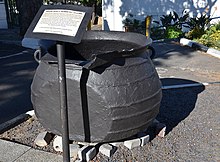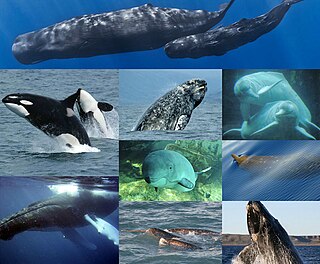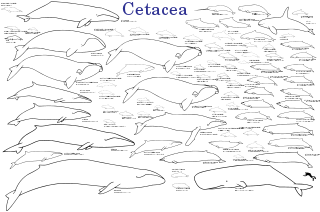
Blubber is a thick layer of vascularized adipose tissue under the skin of all cetaceans, pinnipeds, penguins, and sirenians. It was present in many marine reptiles, such as ichthyosaurs and plesiosaurs. [1]

Blubber is a thick layer of vascularized adipose tissue under the skin of all cetaceans, pinnipeds, penguins, and sirenians. It was present in many marine reptiles, such as ichthyosaurs and plesiosaurs. [1]
Lipid-rich, collagen fiber-laced blubber comprises the hypodermis [2] and covers the whole body, except for parts of the appendages. It is strongly attached to the musculature and skeleton by highly organized, fan-shaped networks of tendons and ligaments, can comprise up to 50 per cent of the body mass of some marine mammals during some points in their lives, and can range from 5 cm (2 in) thick in dolphins and smaller whales, to more than 30 cm (12 in) thick in some bigger whales, such as right and bowhead whales. However, this is not indicative of larger whales' ability to retain heat better, as the thickness of a whale's blubber does not significantly affect heat loss. More indicative of a whale's ability to retain heat is the water and lipid concentration in blubber, as water reduces heat-retaining capacities, and lipid increases them. [3]
Blubber is the primary fat storage on some mammals, specifically those that live in water. It is particularly important for species that feed and breed in different parts of the ocean. During these periods, the animals metabolize fat. Blubber may save energy for marine mammals, such as dolphins, in that it adds buoyancy while swimming. [4]
Blubber differs from other forms of adipose tissue in its extra thickness, which provides an efficient thermal insulator, making blubber essential for thermoregulation. Blubber is more vascularized—rich in blood vessels—than other adipose tissue.
Blubber has advantages over fur (as in sea otters) in that, though fur retains heat by holding pockets of air, the air expels under pressure (i.e., when the animal dives). Blubber, however, does not compress under pressure. It is effective enough that some whales can dwell in temperatures as low as 4 °C (40 °F). [5] While diving in cold water, blood vessels covering the blubber constrict and decrease blood flow, thus increasing blubber's efficiency as an insulator. [6]
Blubber aids buoyancy and streamlines the body, because the organized, complex collagenous network supports the noncircular cross sections characteristic of cetaceans. The buoyancy of blubber could be problematic for bottom-feeding marine mammals such as sirenians and the extinct marine sloths, both of which do or probably did have limited amounts of it for that reason. [7] [8]
Research [9] into the thermal conductivity of the common bottlenose dolphin's blubber reveals its thickness and lipid content vary greatly amongst individuals and across life history categories. Blubber from emaciated dolphins is a poorer insulator than that from nonpregnant adults, which in turn have a higher heat conductivity than blubber from pregnant females and adolescents.

Uqhuq, [10] or uqsuq, [11] ("blubber" in the Inuktitut language) is an important part of the traditional diets of the Inuit and of other northern peoples, because of its high energy value and availability. Whale blubber, which tastes like arrowroot biscuits, has similar properties. [12]
Whaling largely targeted the collection of blubber: whalers rendered it into oil in try pots, or later, in vats on factory ships. The oil could serve in the manufacture of soap, leather, and cosmetics. [13] Whale oil was used in candles as wax, and in oil lamps as fuel. A single blue whale can yield a blubber harvest of up to 50 tons. [14]
Blubber from whales and seals contains omega-3 fatty acids and vitamin D. [15] Without the vitamin D, for example, the Inuit and other natives of the Arctic would likely suffer from rickets. There is evidence blubber and other fats in the arctic diet also provide the calories needed to replace the lack of carbohydrates which are found in the diets of cultures in the rest of the world. [16]
In the 21st century, blubber contains man-made polychlorinated biphenyl (PCBs), carcinogens that damage human nervous, immune, and reproductive systems. [17] [18] The source of PCB concentrations is unknown. Since toothed whales are high on the food chain, they likely consume large amounts of industrial pollutants (bioaccumulation); even baleen whales, by merit of the huge amount of food they consume, are bound to have toxic chemicals stored in their bodies. Additionally, there are high levels of mercury in the blubber of seals of the Canadian arctic. [19]

Cetacea is an infraorder of aquatic mammals belonging to the order Artiodactyla that includes whales, dolphins, and porpoises. Key characteristics are their fully aquatic lifestyle, streamlined body shape, often large size and exclusively carnivorous diet. They propel themselves through the water with powerful up-and-down movement of their tail which ends in a paddle-like fluke, using their flipper-shaped forelimbs to maneuver.

A dolphin is an aquatic mammal within the infraorder Cetacea. Dolphin species belong to the families Delphinidae, Platanistidae, Iniidae, Pontoporiidae, and possibly extinct Lipotidae. There are 40 extant species named as dolphins.

Marine mammals are mammals that rely on marine (saltwater) ecosystems for their existence. They include animals such as cetaceans, pinnipeds, sirenians, sea otters and polar bears. They are an informal group, unified only by their reliance on marine environments for feeding and survival.

Bottlenose dolphins are aquatic mammals in the genus Tursiops. They are common, cosmopolitan members of the family Delphinidae, the family of oceanic dolphins. Molecular studies show the genus contains three species: the common bottlenose dolphin, the Indo-Pacific bottlenose dolphin, and Tamanend's bottlenose dolphin. Others, like the Burrunan dolphin, may be alternately considered their own species or be subspecies of T. aduncus. Bottlenose dolphins inhabit warm and temperate seas worldwide, being found everywhere except for the Arctic and Antarctic Circle regions. Their name derives from the Latin tursio (dolphin) and truncatus for the truncated teeth.

Oceanic dolphins or Delphinidae are a widely distributed family of dolphins that live in the sea. Close to forty extant species are recognised. They include several big species whose common names contain "whale" rather than "dolphin", such as the Globicephalinae. Delphinidae is a family within the superfamily Delphinoidea, which also includes the porpoises (Phocoenidae) and the Monodontidae. River dolphins are relatives of the Delphinoidea.

The toothed whales are a parvorder of cetaceans that includes dolphins, porpoises, and all other whales possessing teeth, such as the beaked whales and sperm whales. 73 species of toothed whales are described. They are one of two living groups of cetaceans, the other being the baleen whales (Mysticeti), which have baleen instead of teeth. The two groups are thought to have diverged around 34 million years ago (mya).

The Indo-Pacific bottlenose dolphin is a species of bottlenose dolphin. This dolphin grows to 2.6 m (8.5 ft) long, and weighs up to 230 kg (510 lb). It lives in the waters around India, northern Australia, South China, the Red Sea, and the eastern coast of Africa. Its back is dark grey and its belly is lighter grey or nearly white with grey spots.

The melon-headed whale, also known less commonly as the electra dolphin, little killer whale, or many-toothed blackfish, is a toothed whale of the oceanic dolphin family (Delphinidae). The common name is derived from the head shape. Melon-headed whales are widely distributed throughout deep tropical and subtropical waters worldwide, but they are rarely encountered at sea. They are found near shore mostly around oceanic islands, such as Hawaii, French Polynesia, and the Philippines.

The melon is a mass of adipose tissue found in the foreheads of all toothed whales. It focuses and modulates the animal's vocalizations and acts as a sound lens. It is thus a key organ involved in communication and echolocation.

The evolution of cetaceans is thought to have begun in the Indian subcontinent from even-toed ungulates (Artiodactyla) 50 million years ago (mya) and to have proceeded over a period of at least 15 million years. Cetaceans are fully aquatic marine mammals belonging to the order Artiodactyla and branched off from other artiodactyls around 50 mya. Cetaceans are thought to have evolved during the Eocene, the second epoch of the present-extending Cenozoic Era. Molecular and morphological analyses suggest Cetacea share a relatively recent closest common ancestor with hippopotami and that they are sister groups. Being mammals, they surface to breathe air; they have 5 finger bones (even-toed) in their fins; they nurse their young; and, despite their fully aquatic life style, they retain many skeletal features from their terrestrial ancestors. Research conducted in the late 1970s in Pakistan revealed several stages in the transition of cetaceans from land to sea.

A flipper is a broad, flattened limb adapted for aquatic locomotion. It refers to the fully webbed, swimming appendages of aquatic vertebrates that are not fish.

Muktuk is a traditional food of the peoples of the Arctic, consisting of whale skin and blubber. It is most often made from the bowhead whale, although the beluga and the narwhal are also used. It is usually consumed raw, but can also be eaten frozen, cooked, or pickled.

Historically Inuit cuisine, which is taken here to include Greenlandic cuisine, Yup'ik cuisine and Aleut cuisine, consisted of a diet of animal source foods that were fished, hunted, and gathered locally.

Bernd Gerhard Würsig is an educator and researcher who works mainly on aspects of behavior and behavioral ecology of whales and dolphins. Much of his early work was done in close collaboration with his wife Melany Ann Würsig, and they have published numerous manuscripts and books together. He is now Professor Emeritus at Texas A&M University, teaching only occasionally but still involved with graduate student and other research. He is especially active with problems and potential solutions concerning Indo-Pacific humpback dolphins, Sousa chinensis, in and surrounding waters of Hong Kong.

Marine mammals are a food source in many countries around the world. Historically, they were hunted by coastal people, and in the case of aboriginal whaling, still are. This sort of subsistence hunting was on a small scale and produced only localised effects. Dolphin drive hunting continues in this vein, from the South Pacific to the North Atlantic. The commercial whaling industry and the maritime fur trade, which had devastating effects on marine mammal populations, did not focus on the animals as food, but for other resources, namely whale oil and seal fur.